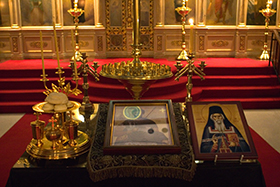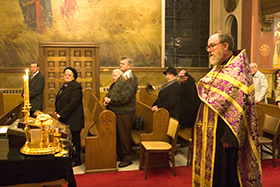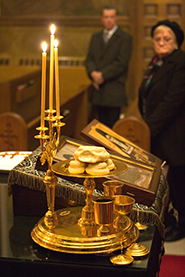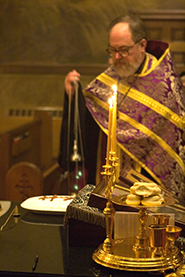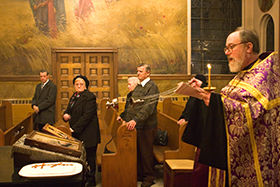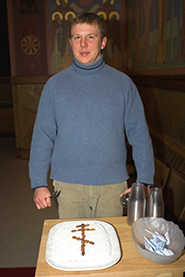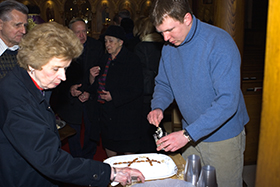Centennial Year Church Services
 |
March 18, 2005 - On the eve of the commemoration of St. Theodore the Recruit - observed on the first Saturday of Great Lent as prescribed by Patriarch Nectarius of Constantinople (381 - 397 A.D.) - the service of Great Compline and Litiya with the Blessing of Koliva was conducted. The tradition of the blessing of koliva (cooked wheat with honey) has its origin as follows. Some fifty years after the repose of St. Theodore, the Emperor Julian the Apostate, having reigned from the year 361 - 363 A.D., continued the persecution of Christians in the city of Constantinople. During the first week of Great Lent, Julian ordered that all foodstuffs in the marketplace be covered with the blood of animals sacrificed to idols. St. Theodore appeared in a dream to Eudoxius, Archbishop of Constantinople, and ordered him to make known to all Christians of the city not to purchase the foodstuffs so contaminated but rather to eat wheat with honey which they had cooked at their homes. After the Blessing of Koliva, scenes of which may be observed below, it is distributed to those parishioners who attended the service.
Above is an icon of St. Theodore the Recruit. Below left is the center Tetrapod before the beginning of the service. At the right of this photo is the icon of St. Nikolai of Zhicha, whose repose is also commemorated on this day. Below right, the Grand Compline with Litiya (the word "litiya" meaning "common prayer") is shown in progress.
Above and below are scenes from the Great Compline with Litiya. Note that the Koliva is already on the center Tetrapod (photo above right) as Father David censes the Tetrapod.
You may click on the photo above right to view an enlargement.
Above and below are scenes of the blessing of the Koliva which occurred after Great Compline with Litiya.
This year's Koliva (above left) was comprised of bulgur wheat (a parched cracked wheat), orange juice, and a little bit of parsley. Sometimes honey is added for sweetness. Atop the Koliva, almonds are arranged in the form of an Orthodox Cross. Above right, Reader Joseph Shaluha is shown with the Koliva that he had prepared.
You may click on the photo above right to view an enlargement.
Plastic cups and spoons facilitate the distribution of the Koliva to parishioners who consume it before departing for home.
return to photos menu
return to homepage
Copyright © 2005, Saints Peter and Paul Orthodox Church, South River, NJ


